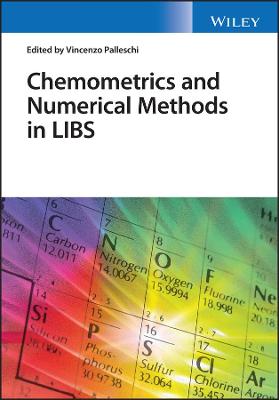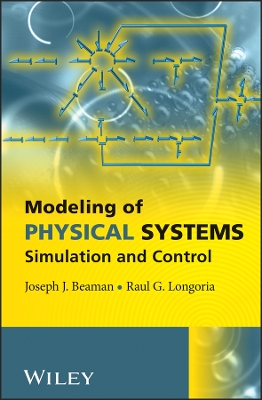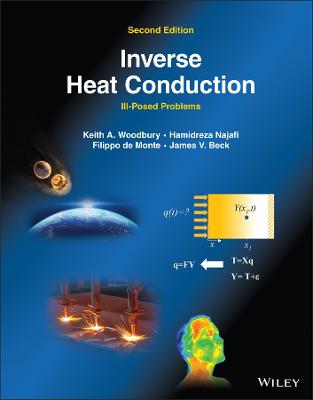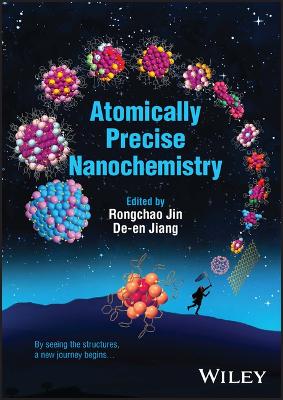Chemometrics and Numerical Methods in LIBS
 -15%
portes grátis
-15%
portes grátis
Chemometrics and Numerical Methods in LIBS
Palleschi, Vincenzo
John Wiley & Sons Inc
11/2022
384
Dura
Inglês
9781119759584
15 a 20 dias
Descrição não disponível.
List of Contributors xiii
Preface xvii
Introduction and Brief Summary of the LIBS Development 1
Part I Introduction to LIBS 5
1 LIBS Fundamentals 7
Mohamad Sabsabi
1.1 Interaction of Laser Beam with Matter 8
1.2 Basics of Laser-Matter Interaction 9
1.3 Processes in Laser-Produced Plasma 10
1.4 Factors Affecting Laser Ablation and Laser-Induced Plasma Formation 11
1.4.1 Influence of Laser Parameters on the Laser-Induced Plasmas 11
1.4.2 Laser Wavelength (?) 12
1.4.3 Laser Pulse Duration (?) 12
1.4.4 Laser Energy (E) 13
1.4.5 Influence of Ambient Gas 13
1.5 Plasma Properties and Plasma Emission Spectra 14
References 15
2 LIBS Instrumentations 19
Mohamad Sabsabi and Vincenzo Palleschi
2.1 Basics of LIBS instrumentations 19
2.2 Lasers in LIBS Systems 20
2.3 Desirable Requirements for Atomic Emission Spectrometers/Detectors 22
2.4 Spectrometers 23
2.4.1 Czerny-Turner Optical Configuration 23
2.4.2 Paschen-Runge Design 24
2.4.3 Echelle Spectrometer Configuration 25
2.5 Detectors 26
2.5.1 Photomultiplier Detectors 26
2.5.2 Solid-State Detectors 27
2.5.3 The Interline CCD Detectors 27
2.5.3.1 The Image Intensifier 28
References 29
3 Applications of LIBS 31
Vincenzo Palleschi and Mohamad Sabsabi
3.1 Industrial Applications 31
3.1.1 Metal Industry 31
3.1.2 Energy Production 34
3.2 Biomedical Applications 34
3.3 Geological and Environmental Applications 36
3.4 Cultural Heritage and Archaeology Applications 37
3.5 Other Applications 37
References 38
Part II Simplications of LIBS Information 45
4 LIBS Spectral Treatment 47
Sabrina Messaoud Aberkane, Noureddine Melikechi and Kenza Yahiaoui
4.1 Introduction 47
4.2 Baseline Correction 47
4.2.1 Polynomial Algorithm 48
4.2.2 Model-free Algorithm 49
4.2.3 Wavelet Transform Model 52
4.3 Noise Filtering 55
4.3.1 Wavelet Threshold De-noising (WTD) 55
4.3.2 Baseline Correction and Noise Filtering 59
4.4 Overlapping Peak Resolution 60
4.4.1 Curve Fitting Method 61
4.4.2 The Wavelet Transform 64
4.5 Features Selection 66
4.5.1 Principal Component Analysis 68
4.5.2 Genetic Algorithm (GA) 68
4.5.3 Wavelet Transformation (WT) 68
References 71
5 Principal Component Analysis 81
Mohamed Abdel-Harith and Zienab Abdel-Salam
5.1 Introduction 81
5.1.1 Laser-Induced Breakdown Spectroscopy (LIBS) 81
5.2 The Principal Component Analysis (PCA) 82
5.3 PCA in Some LIBS Applications 83
5.3.1 Geochemical Applications 83
5.3.2 Food and Feed Applications 85
5.3.3 Microbiological Applications 88
5.3.4 Forensic Applications 91
5.4 Conclusion 94
References 94
6 Time-Dependent Spectral Analysis 97
Fausto Bredice, Ivan Urbina, and Vincenzo Palleschi
6.1 Introduction 97
6.2 Time-Dependent LIBS Spectral Analysis 98
6.2.1 Independent Component Analysis 98
6.2.2 3D Boltzmann Plot 102
6.2.2.1 Principles of the Method 103
6.3 Applications 109
6.3.1 3D Boltzmann Plot Coupled with Independent Component Analysis 109
6.3.2 Analysis of a Carbon Plasma by 3D Boltzmann Plot Method 109
6.3.3 Assessment of the LTE Condition Through the 3D Boltzmann Plot Method 114
6.3.4 Evaluation of Self-Absorption 114
6.3.5 Determination of Transition Probabilities 118
6.3.6 3D Boltzmann Plot and Calibration-free Laser-induced Breakdown Spectroscopy 121
6.4 Conclusion 123
References 123
Part III Classification by LIBS 127
7 Distance-based Method 129
Hua Li and Tianlong Zhang
7.1 Cluster Analysis 132
7.1.1 Introduction 132
7.1.2 Theory 133
7.1.2.1 K-means Clustering 133
7.1.2.2 Hierarchical Clustering 134
7.1.3 Application 135
7.2 Independent Components Analysis 138
7.2.1 Introduction 138
7.2.2 Theory 138
7.2.3 Application 140
7.3 K-Nearest Neighbor 143
7.3.1 Introduction 143
7.3.2 Theory 143
7.3.3 Application 145
7.4 Linear Discriminant Analysis 145
7.4.1 Introduction 145
7.4.2 Theory 148
7.4.2.1 The Calculation Process of LDA (Two Categories) 148
7.4.3 Application 151
7.5 Partial Least Squares Discriminant Analysis 153
7.5.1 Introduction 153
7.5.2 Theory 155
7.5.3 Application 157
7.6 Principal Component Analysis 161
7.6.1 Introduction 161
7.6.2 Theory 164
7.6.3 Application 166
7.7 Soft Independent Modeling of Class Analogy 174
7.7.1 Introduction 174
7.7.2 Theory 175
7.7.3 Application 177
7.8 Conclusion and Expectation 180
References 181
8 Blind Source Separation in LIBS 189
Anna Tonazzini, Emanuele Salerno, and Stefano Pagnotta
8.1 Introduction 189
8.2 Data Model 193
8.3 Analyzing LIBS Data via Blind Source Separation 193
8.3.1 Second-order BSS 193
8.3.2 Maximum Noise Fraction 194
8.3.3 Independent Component Analysis 196
8.3.4 ICA for Noisy Data 197
8.4 Numerical Examples 197
8.5 Final Remarks 206
References 207
9 Artificial Neural Networks for Classification 213
Jakub Vrabel, Erik Kepes, Pavel Porizka, and Jozef Kaiser
9.1 Introduction and Scope 213
9.2 Artificial Neural Networks (ANNs) 214
9.3 Cost Functions and Training 216
9.4 Backpropagation 219
9.5 Convolutional Neural Networks 221
9.6 Evaluation and Tuning of ANNs 224
9.7 Regularization 227
9.8 State-of-the-art LIBS Classification Using ANNs 229
9.9 Summary 233
Acknowledgments 234
References 234
10 Data Fusion: LIBS + Raman 241
Beatrice Campanella and Stefano Legnaioli
10.1 Introduction 241
10.2 Data Fusion Background 242
10.3 Data Treatment 244
10.4 Working with Images 245
10.4.1 Vectors Concatenation 246
10.4.2 Vectors Co-addition 246
10.4.3 Vectors Outer Sum 246
10.4.4 Vectors Outer Product 247
10.4.5 Data Analysis 247
10.5 Applications 248
10.6 Conclusion 253
References 253
Part IV Quantitative Analysis 257
11 Univariate Linear Methods 259
Stefano Legnaioli, Asia Botto, Beatrice Campanella, Francesco Poggialini, Simona Raneri, and Vincenzo Palleschi
11.1 Standards 259
11.2 Matrix Effect 260
11.3 Normalization 261
11.4 Linear vs. Nonlinear Calibration Curves 264
11.5 Figures of Merit of a Calibration Curve 267
11.5.1 Coefficient of Determination 270
11.5.2 Root Mean Squared Error of Calibration 270
11.5.3 Limit of Detection 270
11.6 Inverse Calibration 273
11.7 Conclusion 274
References 274
12 Partial Least Squares 277
Zongyu Hou, Weiran Song, and Zhe Wang
12.1 Overview 277
12.2 Partial Least Squares Regression Algorithms 278
12.2.1 Nonlinear Iterative PLS 278
12.2.2 SIMPLS Algorithm 279
12.2.3 Kernel Partial Least Squares 279
12.2.4 Locally Weighted Partial Least Squares 280
12.2.5 Dominant Factor-based Partial Least Squares 281
12.3 Partial Least Squares Discriminant Analysis 282
12.4 Results of Partial Least Squares in LIBS 283
12.4.1 Coal Analysis 283
12.4.2 Metal Analysis 285
12.4.3 Rocks, Soils, and Minerals Analysis 285
12.4.4 Organics Analysis 291
12.5 Conclusion 291
References 295
13 Nonlinear Methods 303
Francesco Poggialini, Asia Botto, Beatrice Campanella, Stefano Legnaioli, Simona Raneri, and Vincenzo Palleschi
13.1 Introduction 303
13.2 Multivariate Nonlinear Algorithms 304
13.2.1 Artificial Neural Networks 304
13.2.1.1 Conventional Artificial Neural Networks 304
13.2.1.2 Convolutional Neural Networks 310
13.2.2 Other Nonlinear Multivariate Approaches 312
13.2.2.1 The Franzini-Leoni Method 312
13.2.2.2 The Kalman Filter Approach 313
13.2.2.3 Calibration-Free Methods 314
13.3 Conclusion 315
References 316
14 Laser Ablation-based Techniques - Data Fusion 321
Jhanis Gonzalez
14.1 Introduction 321
14.2 Data Fusion of Multiple Analytical Techniques 322
14.2.1 Low-level Fusion 322
14.2.2 Mid-level Fusion 323
14.2.3 High-level Fusion 324
14.3 Data Fusion of Laser Ablation-Based Techniques 324
14.3.1 Introduction 324
14.3.2 Classification of Edible Salts 326
14.3.2.1 LIBS and LA-ICP-MS Measurements of the Salt Samples 327
14.3.2.2 Mid-Level Data Fusion of LIBS and LA-ICP-MS of Salt Samples 327
14.3.2.3 PLS-DA Classification Model for Salt Samples 333
14.3.3 Coal Discrimination Analysis 334
14.3.3.1 LIBS and LA-ICP-TOF-MS Measurements of the Coal Samples 335
14.3.3.2 Mid-Level Data Fusion of LIBS and LA-ICP-TOF-MS of Coal Samples 335
14.3.3.3 PCA Combined with K-means Cluster Analysis for Coal Samples 338
14.3.3.4 PLS-DA and SVM for Coal Samples Analysis 340
14.4 Comments and Future Developments 341
Acknowledgments 343
References 343
Part V Conclusions 347
15 Conclusion 349
Vincenzo Palleschi
Index 351
Preface xvii
Introduction and Brief Summary of the LIBS Development 1
Part I Introduction to LIBS 5
1 LIBS Fundamentals 7
Mohamad Sabsabi
1.1 Interaction of Laser Beam with Matter 8
1.2 Basics of Laser-Matter Interaction 9
1.3 Processes in Laser-Produced Plasma 10
1.4 Factors Affecting Laser Ablation and Laser-Induced Plasma Formation 11
1.4.1 Influence of Laser Parameters on the Laser-Induced Plasmas 11
1.4.2 Laser Wavelength (?) 12
1.4.3 Laser Pulse Duration (?) 12
1.4.4 Laser Energy (E) 13
1.4.5 Influence of Ambient Gas 13
1.5 Plasma Properties and Plasma Emission Spectra 14
References 15
2 LIBS Instrumentations 19
Mohamad Sabsabi and Vincenzo Palleschi
2.1 Basics of LIBS instrumentations 19
2.2 Lasers in LIBS Systems 20
2.3 Desirable Requirements for Atomic Emission Spectrometers/Detectors 22
2.4 Spectrometers 23
2.4.1 Czerny-Turner Optical Configuration 23
2.4.2 Paschen-Runge Design 24
2.4.3 Echelle Spectrometer Configuration 25
2.5 Detectors 26
2.5.1 Photomultiplier Detectors 26
2.5.2 Solid-State Detectors 27
2.5.3 The Interline CCD Detectors 27
2.5.3.1 The Image Intensifier 28
References 29
3 Applications of LIBS 31
Vincenzo Palleschi and Mohamad Sabsabi
3.1 Industrial Applications 31
3.1.1 Metal Industry 31
3.1.2 Energy Production 34
3.2 Biomedical Applications 34
3.3 Geological and Environmental Applications 36
3.4 Cultural Heritage and Archaeology Applications 37
3.5 Other Applications 37
References 38
Part II Simplications of LIBS Information 45
4 LIBS Spectral Treatment 47
Sabrina Messaoud Aberkane, Noureddine Melikechi and Kenza Yahiaoui
4.1 Introduction 47
4.2 Baseline Correction 47
4.2.1 Polynomial Algorithm 48
4.2.2 Model-free Algorithm 49
4.2.3 Wavelet Transform Model 52
4.3 Noise Filtering 55
4.3.1 Wavelet Threshold De-noising (WTD) 55
4.3.2 Baseline Correction and Noise Filtering 59
4.4 Overlapping Peak Resolution 60
4.4.1 Curve Fitting Method 61
4.4.2 The Wavelet Transform 64
4.5 Features Selection 66
4.5.1 Principal Component Analysis 68
4.5.2 Genetic Algorithm (GA) 68
4.5.3 Wavelet Transformation (WT) 68
References 71
5 Principal Component Analysis 81
Mohamed Abdel-Harith and Zienab Abdel-Salam
5.1 Introduction 81
5.1.1 Laser-Induced Breakdown Spectroscopy (LIBS) 81
5.2 The Principal Component Analysis (PCA) 82
5.3 PCA in Some LIBS Applications 83
5.3.1 Geochemical Applications 83
5.3.2 Food and Feed Applications 85
5.3.3 Microbiological Applications 88
5.3.4 Forensic Applications 91
5.4 Conclusion 94
References 94
6 Time-Dependent Spectral Analysis 97
Fausto Bredice, Ivan Urbina, and Vincenzo Palleschi
6.1 Introduction 97
6.2 Time-Dependent LIBS Spectral Analysis 98
6.2.1 Independent Component Analysis 98
6.2.2 3D Boltzmann Plot 102
6.2.2.1 Principles of the Method 103
6.3 Applications 109
6.3.1 3D Boltzmann Plot Coupled with Independent Component Analysis 109
6.3.2 Analysis of a Carbon Plasma by 3D Boltzmann Plot Method 109
6.3.3 Assessment of the LTE Condition Through the 3D Boltzmann Plot Method 114
6.3.4 Evaluation of Self-Absorption 114
6.3.5 Determination of Transition Probabilities 118
6.3.6 3D Boltzmann Plot and Calibration-free Laser-induced Breakdown Spectroscopy 121
6.4 Conclusion 123
References 123
Part III Classification by LIBS 127
7 Distance-based Method 129
Hua Li and Tianlong Zhang
7.1 Cluster Analysis 132
7.1.1 Introduction 132
7.1.2 Theory 133
7.1.2.1 K-means Clustering 133
7.1.2.2 Hierarchical Clustering 134
7.1.3 Application 135
7.2 Independent Components Analysis 138
7.2.1 Introduction 138
7.2.2 Theory 138
7.2.3 Application 140
7.3 K-Nearest Neighbor 143
7.3.1 Introduction 143
7.3.2 Theory 143
7.3.3 Application 145
7.4 Linear Discriminant Analysis 145
7.4.1 Introduction 145
7.4.2 Theory 148
7.4.2.1 The Calculation Process of LDA (Two Categories) 148
7.4.3 Application 151
7.5 Partial Least Squares Discriminant Analysis 153
7.5.1 Introduction 153
7.5.2 Theory 155
7.5.3 Application 157
7.6 Principal Component Analysis 161
7.6.1 Introduction 161
7.6.2 Theory 164
7.6.3 Application 166
7.7 Soft Independent Modeling of Class Analogy 174
7.7.1 Introduction 174
7.7.2 Theory 175
7.7.3 Application 177
7.8 Conclusion and Expectation 180
References 181
8 Blind Source Separation in LIBS 189
Anna Tonazzini, Emanuele Salerno, and Stefano Pagnotta
8.1 Introduction 189
8.2 Data Model 193
8.3 Analyzing LIBS Data via Blind Source Separation 193
8.3.1 Second-order BSS 193
8.3.2 Maximum Noise Fraction 194
8.3.3 Independent Component Analysis 196
8.3.4 ICA for Noisy Data 197
8.4 Numerical Examples 197
8.5 Final Remarks 206
References 207
9 Artificial Neural Networks for Classification 213
Jakub Vrabel, Erik Kepes, Pavel Porizka, and Jozef Kaiser
9.1 Introduction and Scope 213
9.2 Artificial Neural Networks (ANNs) 214
9.3 Cost Functions and Training 216
9.4 Backpropagation 219
9.5 Convolutional Neural Networks 221
9.6 Evaluation and Tuning of ANNs 224
9.7 Regularization 227
9.8 State-of-the-art LIBS Classification Using ANNs 229
9.9 Summary 233
Acknowledgments 234
References 234
10 Data Fusion: LIBS + Raman 241
Beatrice Campanella and Stefano Legnaioli
10.1 Introduction 241
10.2 Data Fusion Background 242
10.3 Data Treatment 244
10.4 Working with Images 245
10.4.1 Vectors Concatenation 246
10.4.2 Vectors Co-addition 246
10.4.3 Vectors Outer Sum 246
10.4.4 Vectors Outer Product 247
10.4.5 Data Analysis 247
10.5 Applications 248
10.6 Conclusion 253
References 253
Part IV Quantitative Analysis 257
11 Univariate Linear Methods 259
Stefano Legnaioli, Asia Botto, Beatrice Campanella, Francesco Poggialini, Simona Raneri, and Vincenzo Palleschi
11.1 Standards 259
11.2 Matrix Effect 260
11.3 Normalization 261
11.4 Linear vs. Nonlinear Calibration Curves 264
11.5 Figures of Merit of a Calibration Curve 267
11.5.1 Coefficient of Determination 270
11.5.2 Root Mean Squared Error of Calibration 270
11.5.3 Limit of Detection 270
11.6 Inverse Calibration 273
11.7 Conclusion 274
References 274
12 Partial Least Squares 277
Zongyu Hou, Weiran Song, and Zhe Wang
12.1 Overview 277
12.2 Partial Least Squares Regression Algorithms 278
12.2.1 Nonlinear Iterative PLS 278
12.2.2 SIMPLS Algorithm 279
12.2.3 Kernel Partial Least Squares 279
12.2.4 Locally Weighted Partial Least Squares 280
12.2.5 Dominant Factor-based Partial Least Squares 281
12.3 Partial Least Squares Discriminant Analysis 282
12.4 Results of Partial Least Squares in LIBS 283
12.4.1 Coal Analysis 283
12.4.2 Metal Analysis 285
12.4.3 Rocks, Soils, and Minerals Analysis 285
12.4.4 Organics Analysis 291
12.5 Conclusion 291
References 295
13 Nonlinear Methods 303
Francesco Poggialini, Asia Botto, Beatrice Campanella, Stefano Legnaioli, Simona Raneri, and Vincenzo Palleschi
13.1 Introduction 303
13.2 Multivariate Nonlinear Algorithms 304
13.2.1 Artificial Neural Networks 304
13.2.1.1 Conventional Artificial Neural Networks 304
13.2.1.2 Convolutional Neural Networks 310
13.2.2 Other Nonlinear Multivariate Approaches 312
13.2.2.1 The Franzini-Leoni Method 312
13.2.2.2 The Kalman Filter Approach 313
13.2.2.3 Calibration-Free Methods 314
13.3 Conclusion 315
References 316
14 Laser Ablation-based Techniques - Data Fusion 321
Jhanis Gonzalez
14.1 Introduction 321
14.2 Data Fusion of Multiple Analytical Techniques 322
14.2.1 Low-level Fusion 322
14.2.2 Mid-level Fusion 323
14.2.3 High-level Fusion 324
14.3 Data Fusion of Laser Ablation-Based Techniques 324
14.3.1 Introduction 324
14.3.2 Classification of Edible Salts 326
14.3.2.1 LIBS and LA-ICP-MS Measurements of the Salt Samples 327
14.3.2.2 Mid-Level Data Fusion of LIBS and LA-ICP-MS of Salt Samples 327
14.3.2.3 PLS-DA Classification Model for Salt Samples 333
14.3.3 Coal Discrimination Analysis 334
14.3.3.1 LIBS and LA-ICP-TOF-MS Measurements of the Coal Samples 335
14.3.3.2 Mid-Level Data Fusion of LIBS and LA-ICP-TOF-MS of Coal Samples 335
14.3.3.3 PCA Combined with K-means Cluster Analysis for Coal Samples 338
14.3.3.4 PLS-DA and SVM for Coal Samples Analysis 340
14.4 Comments and Future Developments 341
Acknowledgments 343
References 343
Part V Conclusions 347
15 Conclusion 349
Vincenzo Palleschi
Index 351
Este título pertence ao(s) assunto(s) indicados(s). Para ver outros títulos clique no assunto desejado.
Feature Selection; Classification methods; Quantitative analysis; Multivariate Analysis; Principal Component Analysis; Partial Least Squares; Artificial Neural Networks; Convolutional Neural Networks; Deep Learning; Big Data; Spectral Angle Mapping; Linear Discriminant Analysis; Advanced statistics in LIBS.
List of Contributors xiii
Preface xvii
Introduction and Brief Summary of the LIBS Development 1
Part I Introduction to LIBS 5
1 LIBS Fundamentals 7
Mohamad Sabsabi
1.1 Interaction of Laser Beam with Matter 8
1.2 Basics of Laser-Matter Interaction 9
1.3 Processes in Laser-Produced Plasma 10
1.4 Factors Affecting Laser Ablation and Laser-Induced Plasma Formation 11
1.4.1 Influence of Laser Parameters on the Laser-Induced Plasmas 11
1.4.2 Laser Wavelength (?) 12
1.4.3 Laser Pulse Duration (?) 12
1.4.4 Laser Energy (E) 13
1.4.5 Influence of Ambient Gas 13
1.5 Plasma Properties and Plasma Emission Spectra 14
References 15
2 LIBS Instrumentations 19
Mohamad Sabsabi and Vincenzo Palleschi
2.1 Basics of LIBS instrumentations 19
2.2 Lasers in LIBS Systems 20
2.3 Desirable Requirements for Atomic Emission Spectrometers/Detectors 22
2.4 Spectrometers 23
2.4.1 Czerny-Turner Optical Configuration 23
2.4.2 Paschen-Runge Design 24
2.4.3 Echelle Spectrometer Configuration 25
2.5 Detectors 26
2.5.1 Photomultiplier Detectors 26
2.5.2 Solid-State Detectors 27
2.5.3 The Interline CCD Detectors 27
2.5.3.1 The Image Intensifier 28
References 29
3 Applications of LIBS 31
Vincenzo Palleschi and Mohamad Sabsabi
3.1 Industrial Applications 31
3.1.1 Metal Industry 31
3.1.2 Energy Production 34
3.2 Biomedical Applications 34
3.3 Geological and Environmental Applications 36
3.4 Cultural Heritage and Archaeology Applications 37
3.5 Other Applications 37
References 38
Part II Simplications of LIBS Information 45
4 LIBS Spectral Treatment 47
Sabrina Messaoud Aberkane, Noureddine Melikechi and Kenza Yahiaoui
4.1 Introduction 47
4.2 Baseline Correction 47
4.2.1 Polynomial Algorithm 48
4.2.2 Model-free Algorithm 49
4.2.3 Wavelet Transform Model 52
4.3 Noise Filtering 55
4.3.1 Wavelet Threshold De-noising (WTD) 55
4.3.2 Baseline Correction and Noise Filtering 59
4.4 Overlapping Peak Resolution 60
4.4.1 Curve Fitting Method 61
4.4.2 The Wavelet Transform 64
4.5 Features Selection 66
4.5.1 Principal Component Analysis 68
4.5.2 Genetic Algorithm (GA) 68
4.5.3 Wavelet Transformation (WT) 68
References 71
5 Principal Component Analysis 81
Mohamed Abdel-Harith and Zienab Abdel-Salam
5.1 Introduction 81
5.1.1 Laser-Induced Breakdown Spectroscopy (LIBS) 81
5.2 The Principal Component Analysis (PCA) 82
5.3 PCA in Some LIBS Applications 83
5.3.1 Geochemical Applications 83
5.3.2 Food and Feed Applications 85
5.3.3 Microbiological Applications 88
5.3.4 Forensic Applications 91
5.4 Conclusion 94
References 94
6 Time-Dependent Spectral Analysis 97
Fausto Bredice, Ivan Urbina, and Vincenzo Palleschi
6.1 Introduction 97
6.2 Time-Dependent LIBS Spectral Analysis 98
6.2.1 Independent Component Analysis 98
6.2.2 3D Boltzmann Plot 102
6.2.2.1 Principles of the Method 103
6.3 Applications 109
6.3.1 3D Boltzmann Plot Coupled with Independent Component Analysis 109
6.3.2 Analysis of a Carbon Plasma by 3D Boltzmann Plot Method 109
6.3.3 Assessment of the LTE Condition Through the 3D Boltzmann Plot Method 114
6.3.4 Evaluation of Self-Absorption 114
6.3.5 Determination of Transition Probabilities 118
6.3.6 3D Boltzmann Plot and Calibration-free Laser-induced Breakdown Spectroscopy 121
6.4 Conclusion 123
References 123
Part III Classification by LIBS 127
7 Distance-based Method 129
Hua Li and Tianlong Zhang
7.1 Cluster Analysis 132
7.1.1 Introduction 132
7.1.2 Theory 133
7.1.2.1 K-means Clustering 133
7.1.2.2 Hierarchical Clustering 134
7.1.3 Application 135
7.2 Independent Components Analysis 138
7.2.1 Introduction 138
7.2.2 Theory 138
7.2.3 Application 140
7.3 K-Nearest Neighbor 143
7.3.1 Introduction 143
7.3.2 Theory 143
7.3.3 Application 145
7.4 Linear Discriminant Analysis 145
7.4.1 Introduction 145
7.4.2 Theory 148
7.4.2.1 The Calculation Process of LDA (Two Categories) 148
7.4.3 Application 151
7.5 Partial Least Squares Discriminant Analysis 153
7.5.1 Introduction 153
7.5.2 Theory 155
7.5.3 Application 157
7.6 Principal Component Analysis 161
7.6.1 Introduction 161
7.6.2 Theory 164
7.6.3 Application 166
7.7 Soft Independent Modeling of Class Analogy 174
7.7.1 Introduction 174
7.7.2 Theory 175
7.7.3 Application 177
7.8 Conclusion and Expectation 180
References 181
8 Blind Source Separation in LIBS 189
Anna Tonazzini, Emanuele Salerno, and Stefano Pagnotta
8.1 Introduction 189
8.2 Data Model 193
8.3 Analyzing LIBS Data via Blind Source Separation 193
8.3.1 Second-order BSS 193
8.3.2 Maximum Noise Fraction 194
8.3.3 Independent Component Analysis 196
8.3.4 ICA for Noisy Data 197
8.4 Numerical Examples 197
8.5 Final Remarks 206
References 207
9 Artificial Neural Networks for Classification 213
Jakub Vrabel, Erik Kepes, Pavel Porizka, and Jozef Kaiser
9.1 Introduction and Scope 213
9.2 Artificial Neural Networks (ANNs) 214
9.3 Cost Functions and Training 216
9.4 Backpropagation 219
9.5 Convolutional Neural Networks 221
9.6 Evaluation and Tuning of ANNs 224
9.7 Regularization 227
9.8 State-of-the-art LIBS Classification Using ANNs 229
9.9 Summary 233
Acknowledgments 234
References 234
10 Data Fusion: LIBS + Raman 241
Beatrice Campanella and Stefano Legnaioli
10.1 Introduction 241
10.2 Data Fusion Background 242
10.3 Data Treatment 244
10.4 Working with Images 245
10.4.1 Vectors Concatenation 246
10.4.2 Vectors Co-addition 246
10.4.3 Vectors Outer Sum 246
10.4.4 Vectors Outer Product 247
10.4.5 Data Analysis 247
10.5 Applications 248
10.6 Conclusion 253
References 253
Part IV Quantitative Analysis 257
11 Univariate Linear Methods 259
Stefano Legnaioli, Asia Botto, Beatrice Campanella, Francesco Poggialini, Simona Raneri, and Vincenzo Palleschi
11.1 Standards 259
11.2 Matrix Effect 260
11.3 Normalization 261
11.4 Linear vs. Nonlinear Calibration Curves 264
11.5 Figures of Merit of a Calibration Curve 267
11.5.1 Coefficient of Determination 270
11.5.2 Root Mean Squared Error of Calibration 270
11.5.3 Limit of Detection 270
11.6 Inverse Calibration 273
11.7 Conclusion 274
References 274
12 Partial Least Squares 277
Zongyu Hou, Weiran Song, and Zhe Wang
12.1 Overview 277
12.2 Partial Least Squares Regression Algorithms 278
12.2.1 Nonlinear Iterative PLS 278
12.2.2 SIMPLS Algorithm 279
12.2.3 Kernel Partial Least Squares 279
12.2.4 Locally Weighted Partial Least Squares 280
12.2.5 Dominant Factor-based Partial Least Squares 281
12.3 Partial Least Squares Discriminant Analysis 282
12.4 Results of Partial Least Squares in LIBS 283
12.4.1 Coal Analysis 283
12.4.2 Metal Analysis 285
12.4.3 Rocks, Soils, and Minerals Analysis 285
12.4.4 Organics Analysis 291
12.5 Conclusion 291
References 295
13 Nonlinear Methods 303
Francesco Poggialini, Asia Botto, Beatrice Campanella, Stefano Legnaioli, Simona Raneri, and Vincenzo Palleschi
13.1 Introduction 303
13.2 Multivariate Nonlinear Algorithms 304
13.2.1 Artificial Neural Networks 304
13.2.1.1 Conventional Artificial Neural Networks 304
13.2.1.2 Convolutional Neural Networks 310
13.2.2 Other Nonlinear Multivariate Approaches 312
13.2.2.1 The Franzini-Leoni Method 312
13.2.2.2 The Kalman Filter Approach 313
13.2.2.3 Calibration-Free Methods 314
13.3 Conclusion 315
References 316
14 Laser Ablation-based Techniques - Data Fusion 321
Jhanis Gonzalez
14.1 Introduction 321
14.2 Data Fusion of Multiple Analytical Techniques 322
14.2.1 Low-level Fusion 322
14.2.2 Mid-level Fusion 323
14.2.3 High-level Fusion 324
14.3 Data Fusion of Laser Ablation-Based Techniques 324
14.3.1 Introduction 324
14.3.2 Classification of Edible Salts 326
14.3.2.1 LIBS and LA-ICP-MS Measurements of the Salt Samples 327
14.3.2.2 Mid-Level Data Fusion of LIBS and LA-ICP-MS of Salt Samples 327
14.3.2.3 PLS-DA Classification Model for Salt Samples 333
14.3.3 Coal Discrimination Analysis 334
14.3.3.1 LIBS and LA-ICP-TOF-MS Measurements of the Coal Samples 335
14.3.3.2 Mid-Level Data Fusion of LIBS and LA-ICP-TOF-MS of Coal Samples 335
14.3.3.3 PCA Combined with K-means Cluster Analysis for Coal Samples 338
14.3.3.4 PLS-DA and SVM for Coal Samples Analysis 340
14.4 Comments and Future Developments 341
Acknowledgments 343
References 343
Part V Conclusions 347
15 Conclusion 349
Vincenzo Palleschi
Index 351
Preface xvii
Introduction and Brief Summary of the LIBS Development 1
Part I Introduction to LIBS 5
1 LIBS Fundamentals 7
Mohamad Sabsabi
1.1 Interaction of Laser Beam with Matter 8
1.2 Basics of Laser-Matter Interaction 9
1.3 Processes in Laser-Produced Plasma 10
1.4 Factors Affecting Laser Ablation and Laser-Induced Plasma Formation 11
1.4.1 Influence of Laser Parameters on the Laser-Induced Plasmas 11
1.4.2 Laser Wavelength (?) 12
1.4.3 Laser Pulse Duration (?) 12
1.4.4 Laser Energy (E) 13
1.4.5 Influence of Ambient Gas 13
1.5 Plasma Properties and Plasma Emission Spectra 14
References 15
2 LIBS Instrumentations 19
Mohamad Sabsabi and Vincenzo Palleschi
2.1 Basics of LIBS instrumentations 19
2.2 Lasers in LIBS Systems 20
2.3 Desirable Requirements for Atomic Emission Spectrometers/Detectors 22
2.4 Spectrometers 23
2.4.1 Czerny-Turner Optical Configuration 23
2.4.2 Paschen-Runge Design 24
2.4.3 Echelle Spectrometer Configuration 25
2.5 Detectors 26
2.5.1 Photomultiplier Detectors 26
2.5.2 Solid-State Detectors 27
2.5.3 The Interline CCD Detectors 27
2.5.3.1 The Image Intensifier 28
References 29
3 Applications of LIBS 31
Vincenzo Palleschi and Mohamad Sabsabi
3.1 Industrial Applications 31
3.1.1 Metal Industry 31
3.1.2 Energy Production 34
3.2 Biomedical Applications 34
3.3 Geological and Environmental Applications 36
3.4 Cultural Heritage and Archaeology Applications 37
3.5 Other Applications 37
References 38
Part II Simplications of LIBS Information 45
4 LIBS Spectral Treatment 47
Sabrina Messaoud Aberkane, Noureddine Melikechi and Kenza Yahiaoui
4.1 Introduction 47
4.2 Baseline Correction 47
4.2.1 Polynomial Algorithm 48
4.2.2 Model-free Algorithm 49
4.2.3 Wavelet Transform Model 52
4.3 Noise Filtering 55
4.3.1 Wavelet Threshold De-noising (WTD) 55
4.3.2 Baseline Correction and Noise Filtering 59
4.4 Overlapping Peak Resolution 60
4.4.1 Curve Fitting Method 61
4.4.2 The Wavelet Transform 64
4.5 Features Selection 66
4.5.1 Principal Component Analysis 68
4.5.2 Genetic Algorithm (GA) 68
4.5.3 Wavelet Transformation (WT) 68
References 71
5 Principal Component Analysis 81
Mohamed Abdel-Harith and Zienab Abdel-Salam
5.1 Introduction 81
5.1.1 Laser-Induced Breakdown Spectroscopy (LIBS) 81
5.2 The Principal Component Analysis (PCA) 82
5.3 PCA in Some LIBS Applications 83
5.3.1 Geochemical Applications 83
5.3.2 Food and Feed Applications 85
5.3.3 Microbiological Applications 88
5.3.4 Forensic Applications 91
5.4 Conclusion 94
References 94
6 Time-Dependent Spectral Analysis 97
Fausto Bredice, Ivan Urbina, and Vincenzo Palleschi
6.1 Introduction 97
6.2 Time-Dependent LIBS Spectral Analysis 98
6.2.1 Independent Component Analysis 98
6.2.2 3D Boltzmann Plot 102
6.2.2.1 Principles of the Method 103
6.3 Applications 109
6.3.1 3D Boltzmann Plot Coupled with Independent Component Analysis 109
6.3.2 Analysis of a Carbon Plasma by 3D Boltzmann Plot Method 109
6.3.3 Assessment of the LTE Condition Through the 3D Boltzmann Plot Method 114
6.3.4 Evaluation of Self-Absorption 114
6.3.5 Determination of Transition Probabilities 118
6.3.6 3D Boltzmann Plot and Calibration-free Laser-induced Breakdown Spectroscopy 121
6.4 Conclusion 123
References 123
Part III Classification by LIBS 127
7 Distance-based Method 129
Hua Li and Tianlong Zhang
7.1 Cluster Analysis 132
7.1.1 Introduction 132
7.1.2 Theory 133
7.1.2.1 K-means Clustering 133
7.1.2.2 Hierarchical Clustering 134
7.1.3 Application 135
7.2 Independent Components Analysis 138
7.2.1 Introduction 138
7.2.2 Theory 138
7.2.3 Application 140
7.3 K-Nearest Neighbor 143
7.3.1 Introduction 143
7.3.2 Theory 143
7.3.3 Application 145
7.4 Linear Discriminant Analysis 145
7.4.1 Introduction 145
7.4.2 Theory 148
7.4.2.1 The Calculation Process of LDA (Two Categories) 148
7.4.3 Application 151
7.5 Partial Least Squares Discriminant Analysis 153
7.5.1 Introduction 153
7.5.2 Theory 155
7.5.3 Application 157
7.6 Principal Component Analysis 161
7.6.1 Introduction 161
7.6.2 Theory 164
7.6.3 Application 166
7.7 Soft Independent Modeling of Class Analogy 174
7.7.1 Introduction 174
7.7.2 Theory 175
7.7.3 Application 177
7.8 Conclusion and Expectation 180
References 181
8 Blind Source Separation in LIBS 189
Anna Tonazzini, Emanuele Salerno, and Stefano Pagnotta
8.1 Introduction 189
8.2 Data Model 193
8.3 Analyzing LIBS Data via Blind Source Separation 193
8.3.1 Second-order BSS 193
8.3.2 Maximum Noise Fraction 194
8.3.3 Independent Component Analysis 196
8.3.4 ICA for Noisy Data 197
8.4 Numerical Examples 197
8.5 Final Remarks 206
References 207
9 Artificial Neural Networks for Classification 213
Jakub Vrabel, Erik Kepes, Pavel Porizka, and Jozef Kaiser
9.1 Introduction and Scope 213
9.2 Artificial Neural Networks (ANNs) 214
9.3 Cost Functions and Training 216
9.4 Backpropagation 219
9.5 Convolutional Neural Networks 221
9.6 Evaluation and Tuning of ANNs 224
9.7 Regularization 227
9.8 State-of-the-art LIBS Classification Using ANNs 229
9.9 Summary 233
Acknowledgments 234
References 234
10 Data Fusion: LIBS + Raman 241
Beatrice Campanella and Stefano Legnaioli
10.1 Introduction 241
10.2 Data Fusion Background 242
10.3 Data Treatment 244
10.4 Working with Images 245
10.4.1 Vectors Concatenation 246
10.4.2 Vectors Co-addition 246
10.4.3 Vectors Outer Sum 246
10.4.4 Vectors Outer Product 247
10.4.5 Data Analysis 247
10.5 Applications 248
10.6 Conclusion 253
References 253
Part IV Quantitative Analysis 257
11 Univariate Linear Methods 259
Stefano Legnaioli, Asia Botto, Beatrice Campanella, Francesco Poggialini, Simona Raneri, and Vincenzo Palleschi
11.1 Standards 259
11.2 Matrix Effect 260
11.3 Normalization 261
11.4 Linear vs. Nonlinear Calibration Curves 264
11.5 Figures of Merit of a Calibration Curve 267
11.5.1 Coefficient of Determination 270
11.5.2 Root Mean Squared Error of Calibration 270
11.5.3 Limit of Detection 270
11.6 Inverse Calibration 273
11.7 Conclusion 274
References 274
12 Partial Least Squares 277
Zongyu Hou, Weiran Song, and Zhe Wang
12.1 Overview 277
12.2 Partial Least Squares Regression Algorithms 278
12.2.1 Nonlinear Iterative PLS 278
12.2.2 SIMPLS Algorithm 279
12.2.3 Kernel Partial Least Squares 279
12.2.4 Locally Weighted Partial Least Squares 280
12.2.5 Dominant Factor-based Partial Least Squares 281
12.3 Partial Least Squares Discriminant Analysis 282
12.4 Results of Partial Least Squares in LIBS 283
12.4.1 Coal Analysis 283
12.4.2 Metal Analysis 285
12.4.3 Rocks, Soils, and Minerals Analysis 285
12.4.4 Organics Analysis 291
12.5 Conclusion 291
References 295
13 Nonlinear Methods 303
Francesco Poggialini, Asia Botto, Beatrice Campanella, Stefano Legnaioli, Simona Raneri, and Vincenzo Palleschi
13.1 Introduction 303
13.2 Multivariate Nonlinear Algorithms 304
13.2.1 Artificial Neural Networks 304
13.2.1.1 Conventional Artificial Neural Networks 304
13.2.1.2 Convolutional Neural Networks 310
13.2.2 Other Nonlinear Multivariate Approaches 312
13.2.2.1 The Franzini-Leoni Method 312
13.2.2.2 The Kalman Filter Approach 313
13.2.2.3 Calibration-Free Methods 314
13.3 Conclusion 315
References 316
14 Laser Ablation-based Techniques - Data Fusion 321
Jhanis Gonzalez
14.1 Introduction 321
14.2 Data Fusion of Multiple Analytical Techniques 322
14.2.1 Low-level Fusion 322
14.2.2 Mid-level Fusion 323
14.2.3 High-level Fusion 324
14.3 Data Fusion of Laser Ablation-Based Techniques 324
14.3.1 Introduction 324
14.3.2 Classification of Edible Salts 326
14.3.2.1 LIBS and LA-ICP-MS Measurements of the Salt Samples 327
14.3.2.2 Mid-Level Data Fusion of LIBS and LA-ICP-MS of Salt Samples 327
14.3.2.3 PLS-DA Classification Model for Salt Samples 333
14.3.3 Coal Discrimination Analysis 334
14.3.3.1 LIBS and LA-ICP-TOF-MS Measurements of the Coal Samples 335
14.3.3.2 Mid-Level Data Fusion of LIBS and LA-ICP-TOF-MS of Coal Samples 335
14.3.3.3 PCA Combined with K-means Cluster Analysis for Coal Samples 338
14.3.3.4 PLS-DA and SVM for Coal Samples Analysis 340
14.4 Comments and Future Developments 341
Acknowledgments 343
References 343
Part V Conclusions 347
15 Conclusion 349
Vincenzo Palleschi
Index 351
Este título pertence ao(s) assunto(s) indicados(s). Para ver outros títulos clique no assunto desejado.
Feature Selection; Classification methods; Quantitative analysis; Multivariate Analysis; Principal Component Analysis; Partial Least Squares; Artificial Neural Networks; Convolutional Neural Networks; Deep Learning; Big Data; Spectral Angle Mapping; Linear Discriminant Analysis; Advanced statistics in LIBS.







